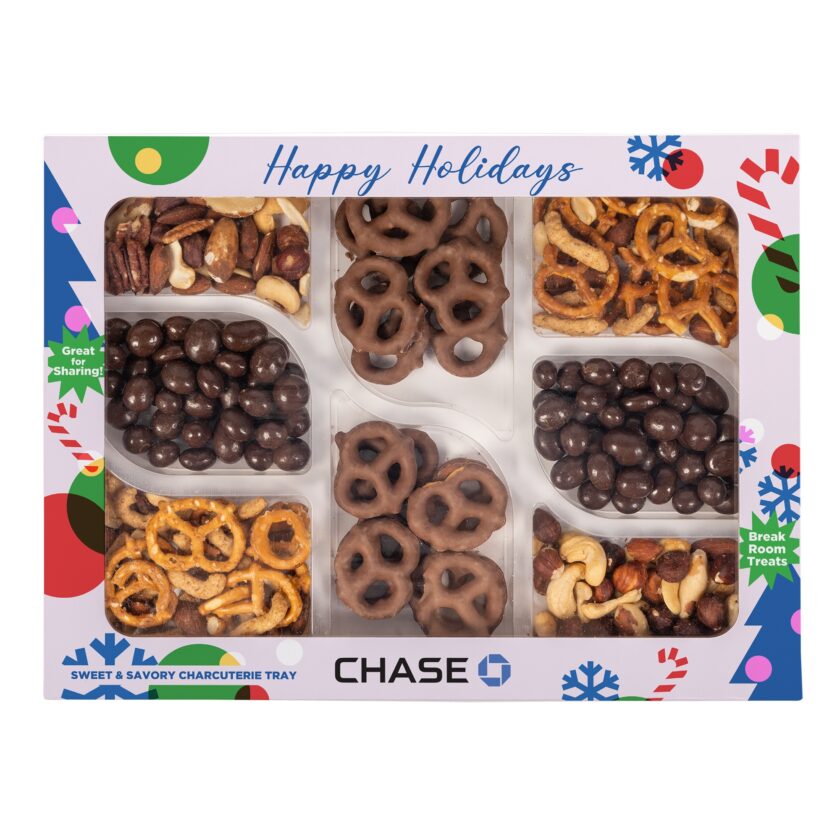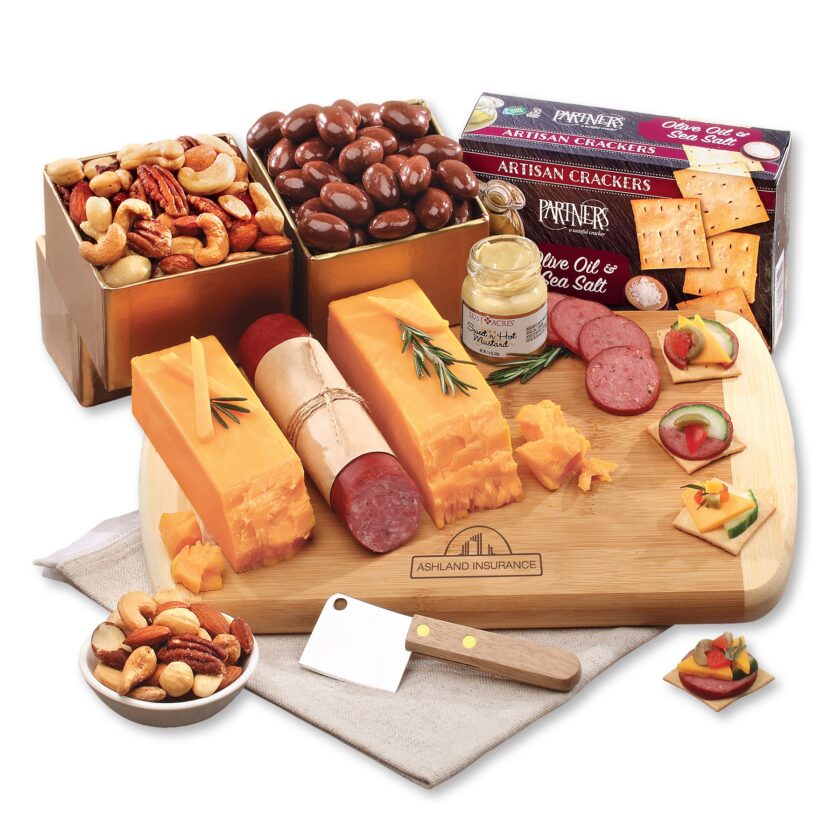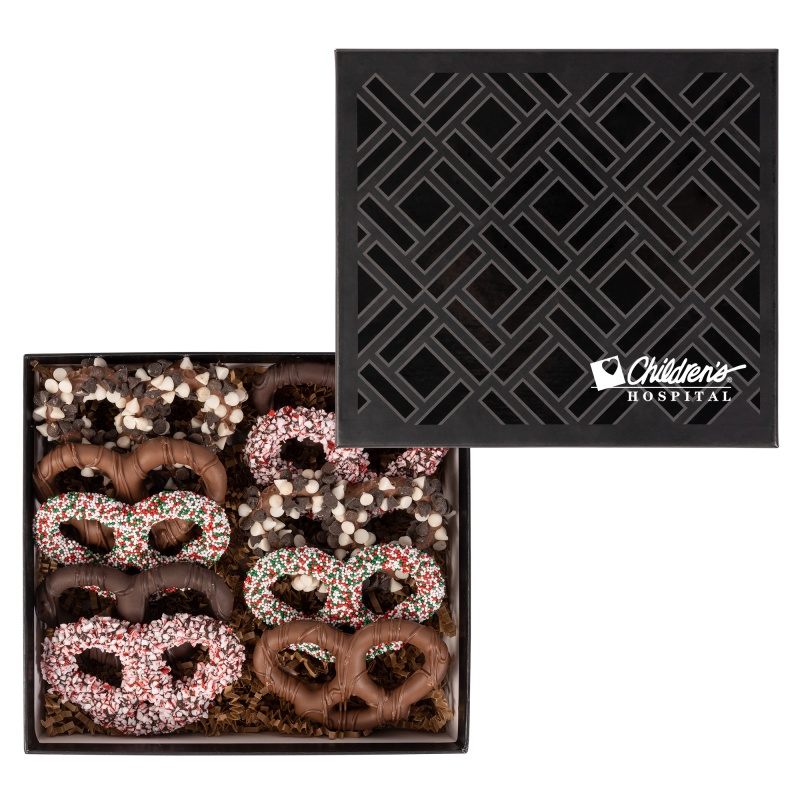Year after year, food ranks as one of the most popular gifts during the holiday season, with companies purchasing directly from brands like Godiva, Edible Arrangements, and Harry & David. Chocolate, artisanal snacks, coffee and tea, cheese and charcuterie, gum and mints, baked goods, wine, crackers – manufacturers cover it all.
Corporate and consumer food gift sales reached $33 billion in 2021, according to Edible Arrangements. The tally is expected to keep growing as companies increasingly use food gifts to maintain relationships with clients, employees and partners.
For sure, edible gifts help power business in the promotional products industry, too. ASI Research shows that branded merch initiatives involving food account for over $250 million in annual promo industry sales. Still, purveyors of delectable delicacies believe there’s opportunity for food’s portion of the promo pie to grow given end-user’s love of a tasty gift around the holidays.
Here, suppliers and distributors share tips for capitalizing on the food category and its unique opportunities.

What’s the Leave-Behind?
Executing a campaign with food items requires attention to manufacturing and shipping logistics, as well as food sensitivities and personal taste preferences. However, the most common question suppliers hear is: “What is the leave-behind?” Essentially, clients want to know how their brand will be remembered after the food is consumed.
David Katz, partner at Midnite Snax (asi/71685), a manufacturer of custom popcorn, chocolate, and baked goods, addresses this topic frequently. “Think of your favorite restaurant: the smell, the taste, the ambiance,” Katz says. “Now think about how many people you’ve told about that restaurant. The strongest leave-behind is your memory, not just a branded coaster.”
Food engages all five senses, which taps into biological programming that influences decision-making. Psychologically, people associate food with care and connection, which warms the recipient to the brand behind the gift. “Breaking bread with someone has always symbolized connection, and that carries over into business relationships as well,” says Jodie Schillinger, executive vice president of Wisconsin-based Maple Ridge Farms (asi/68680), which specializes in food gifts.
Plus, having fewer, but smarter, leave-behinds isn’t necessarily a negative. Younger consumers are embracing minimalism, seeking meaningful and ethical gifts that include options for sustainable packaging, fair-trade sourcing and organic practices that have the least overall footprint. “Food is an incredibly eco-friendly option considering that you eat most of the product and the packaging can be recyclable or compostable,” says David Miller, CEO of Counselor Top 40 supplier NC Custom (asi/44900). “Less is more in the eyes of consumers now. You have to be intentional with your ingredients, packing materials and brand strategy.”
Customization & Kitting
Food gifts might seem fleeting, but once the end-user enjoys the treats, the sender’s message often lingers. If paired with branded hard goods, the campaign is even more impactful.
“There are so many vessels and accessories that can be cleverly decorated alongside food,” says Janie Gaunce, president of Grapevine Designs (asi/212829). “From popcorn and bubble gum in branded stadium cups for an executive baseball outing to conference kits with your city’s best coffee and barbecue sauces, food evokes deeper emotion and adds to a storyline more than any other product category.”

Grapevine Designs, a distributor that handles its own kitting, has assembled seemingly countless custom kits in the last year alone. “One client called and wanted to have 19,000 custom kits shipped to employees to coincide with a webinar they were hosting – in just three weeks – and we did it,” Gaunce recalls. “Our goal is always for the end-user to receive that product and say, ‘Wow, I can’t believe my company thought of this!’”
Miller believes food gifts hold the key to meeting growing demand for hyper-customization. “Direct vendors aren’t usually very creative, but they win business because customers don’t realize they can buy food through their distributor,” Miller explains. “Out of 10,000 SKUs, our most popular product is ‘custom’ because it creates a more impactful brand experience and allows for better margins.”
NC Custom manages its manufacturing and fulfillment in-house, from the custom chocolate molds and edible inks to the full-color retail boxes and its new certified-compostable DigiBag packaging. “Food offers the highest level of personalization,” Miller says. “It’s an interactive, multi-sensory experience that can’t be matched by hard goods and apparel alone.”
Midnite Snax operates similarly, handling its own production process from start to finish and manufacturing for major brands that can be seen on shelves in Macy’s, Nordstrom and other popular department stores. “Promotional customers want to recreate what they see in retail with four-color process cylinders, personalized tins and gourmet sweets kits,” Katz says. “Fortunately, we can do that because we’re behind the scenes of it all. We have a 120,000-square-foot facility pumping out fresh made-to-order treats, as well as custom boxes, bags and packaging. It’s like the Willy Wonka factory here.”
Selling Food Year-Round
Midnite Snax’s staff triples from September to January to meet holiday demand, and Maple Ridge Farms hires additional customer service reps during that period, too. Sure, that highlights the demand that drives the holiday rush. But, rest assured, opportunities to use food promotions exist year-round – especially when focusing on savory treats or unique flavors.
One insider tip for distributors is to explore other budget categories beyond holiday gifts. “Companies have budgets for referral programs, wellness initiatives, sales promotions, travel and more,” says Schillinger. “Distributors should be showing food and asking their customers directly how food promotions can fit into these categories.”

Maple Ridge Farms provides educational resources, social media content and experiential tastings to help distributors sell food gifts more effectively. A recent interactive tasting at a national sales meeting for a Counselor Top 40 distributor illustrated this approach. “We shipped all the supplies, including a 30-pound cheese wheel,” Schillinger recalls. “We also set up life-size charcuterie boards on conference tables and created an experience where reps could taste and learn about our offerings.”
But that wasn’t all. Schillinger continues: “We did bread dripping with olive oil and cheese wedges in more shapes than you can imagine. The event led to the most Zoom meetings we’ve ever scheduled from a single tasting. Distributors kept telling us, ‘Now I know how to sell food.’”
Gaunce adds that food items are a valuable player in the growing trend of digital pop-up shops. “A pop-up shop is a time-sensitive online store that we design and build for customers to go live for a determined period of time, and it offers a handful of branded items for employees to choose from,” explains Gaunce. “A company can host a pop-up for recognition programs, onboarding, anniversaries and other initiatives, including to share new internal core values – any reason, really. When the online shop closes, we fulfill those orders through our kitting services. Food gifts work really well in this space.”
Time To Dig In
As the edible gift market continues to grow, so too does the opportunity for distributors to create memorable, brand-driven experiences.
With recipients more likely to do business with a company after receiving a food gift, it’s clear that food promos deliver more than short-term satisfaction – they’re a strategic tool for lasting engagement. “I’ve said it before, and it still rings true: Your customers are buying food somewhere,” says Katz. “Make sure it’s from you.”


